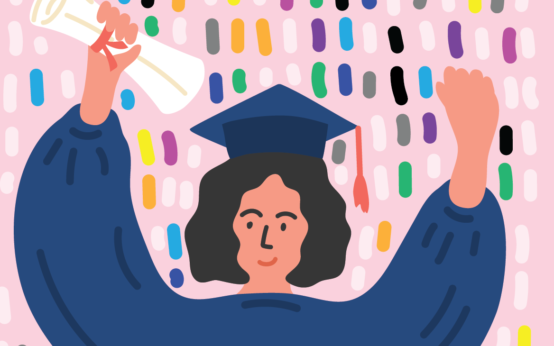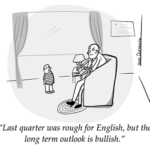Increasing college enrollments required support from across the school, district, and community — and possibly the sacrifice of other important work.
When debating how best to improve college access and success for all students, educators often single out high school guidance counselors, who can play a key role in steering young people — particularly those who would be the first in their family to attend college — toward resources that will help them on the journey to and through higher education. Across the country, however, counseling offices tend to be understaffed, and most counselors are burdened with large caseloads and competing demands (O’Connor, 2018).
To better understand what it takes for counseling to fulfill its promise in helping students achieve their college dreams, we conducted an intensive research study at a public urban high school in the midwestern United States — serving almost 2,000 students, most of whom are low-income and minority — that is reputed to have built an extraordinarily strong advising program.
The school, which we’re calling Urban High School (UHS), has expressed a strong commitment to supporting college going, and recent statistics suggest that this commitment is bearing fruit. The percentage of students enrolling in college within 16 months of graduation from UHS is 20 percentage points higher than the districtwide average and 10 percentage points higher than the statewide average.
What role, we wanted to know, have counselors played in raising this school’s college enrollment rate to such levels? What organizational conditions and supports have enabled them to play that role? And what sacrifices and challenges have they encountered in pursuing this mission?
To achieve such exceptional results, we found, UHS relies on a combination of three key elements:
Strong school leadership
We found the support and effort of a very committed principal to be instrumental in enabling counselors to achieve UHS’s college-enrollment goals. The principal has identified college going as the school’s priority and worked to get everybody on board. In the words of one counselor, “Our principal has chosen a one-word mission statement, and that mission statement is college.” Echoing this, another counselor explained, “With our current principal, [the school climate is] one word: college. So every class from your AP classes to your regular ed classes, from English to P.E., has a core of preparing students for college.”
The principal has identified college going as the school’s priority and worked to get everybody on board.
Further, the principal strongly emphasizes four-year college, urging counselors to point students toward the most selective institution they are qualified to attend. The principal also provides students with concrete examples of how to plan effectively for college. For instance, she was directly involved in helping a group of high-achieving students build a record of activities and experiences that would support their applications to selective four-year colleges. As a counselor explained, the students in this group “are doing service, they’re doing leadership, they’re running for student council,” and “the principal is helping them build the package” for their college application. This work is essential because without a support network encouraging them to take such steps, low-income students — even very high achievers — are less likely to identify an appropriate list of colleges and consider more selective institutions (Roderick et al., 2009).
The principal also has stressed the importance of monitoring students’ progress during the college-application process and nudging students who need it at each stage. A counselor explained, “Our principal is very vigilant about making sure every student applies to college. She has a list in her office that has students that have not applied to college, [and] she’ll stop them in the hallway and say, ‘You need to turn in your college application.’”
Additionally, she constantly encourages counselors to follow her lead: “The principal makes us go after them . . . she really wants for every student to apply to a college.” Following the principal’s example, the counselors systematically keep track of students’ applications, and when a student’s application process is delayed, counselors remind them to complete the necessary steps to meet deadlines. This initiative has been critically important because, especially for low-income students, difficulties managing competing demands present one of the most common barriers to enrolling in college, with even high-achieving students reporting that they wished they were “pushed more” (Roderick et al., 2009).
Strong district-level support
In an effort to improve both overall college-going rates and the match between students and colleges, the district set aside funds to hire full-time college advisers whose only job is to assist students with their postsecondary plans at each of several diverse high schools, including UHS. These advisers do not have any competing tasks and are not subject to the same paperwork and scheduling duties that counselors often have to deal with, so they can focus solely on helping students at each stage of the college application process.
Researchers have argued that:
counseling departments that include at least one counselor who is specifically focused on college applications or college selection may be better able to smooth students’ path to college than counseling departments where all counselors take on all of the issues that come to the department (Radford, Ifill, & Lew, 2016, p. 4).
We found this to be true at UHS, where the college adviser works well with other counselors and helps them achieve the school’s college-enrollment goals.
The district also partners with many externally funded programs that provide college-related supports for students. However, UHS is unique in that while these programs often work toward a college goal with a carefully selected group of students, UHS emphasizes helping all its students find the best possible postsecondary match, and initiatives throughout the institution encourage college, with the message becoming a constant refrain from all staff, at all times, and with few competing goals.
Strong relationships with colleges
UHS is located near a public college and a selective private college, and this proximity has likely contributed to the school’s college-focused culture. For example, both institutions have ongoing relationships with UHS, and their faculty and undergraduates often visit the high school to talk with students about higher education and help them with their college application essays.
However, merely having colleges nearby doesn’t necessarily translate to additional resources. Other high schools in this district have not been as proactive in building relationships with these institutions, and they have not seen the same benefits. UHS stands out in that its principal, counselors, and teachers have been deliberate in reaching out to them, and to more distant colleges as well, repeatedly seeking out opportunities for their students. As one counselor noted:
Everybody in this office has a personal relationship with somebody [at colleges]. Our principal, too, has connections. So, [counselors] don’t just look towards the ones that we have. Such and such who teaches English says she has connections with such and such school. She’ll call for this kid . . . It’s like a [supportive] family.
Personal relationships with college representatives are often helpful in getting marginal students admitted, counselors explained to us. One related that when she sees value in a student who may not have exemplary test scores and grades, she tells the college representative that “if you take a chance [and] give them the support . . . the tutoring, the mentoring, the bridge programs, [I am certain the student will] graduate and come back and contribute to society.” Colleges tend to trust the counselors’ judgment because they know that the counselors value their relationship and would not risk losing it by guiding them wrong. As the counselor explained, “If we’ve said that before, and that’s been proven before, they’re like, ‘OK, we believe you, let us take a look.’”
What kind of counseling? Balancing competing goals
While counselors at UHS were generally supportive of the school’s priorities, they also expressed misgivings about the trade-offs they have to make to focus so intently on moving students toward higher education. Some counselors told us that the school’s college climate is “very ambitious, very aggressive,” and they worried about college conversation “overkill.” As one counselor lamented, this one-size-fits-all approach — with teachers, counselors, and administrators all sending the message that going to college after high school is “the natural order of things” — may not be serving students who have other plans.
Counselors told us that they would like to spend more time helping students with social-emotional problems but are not able to do so because college guidance, the school’s priority, takes most of their time.
Furthermore, counselors told us that they would like to spend more time helping students with social-emotional problems but are not able to do so because college guidance, the school’s priority, takes most of their time. One counselor explained that students “are not really able to learn effectively when they’re dealing with issues they can’t address anywhere else.” The relentless focus on college makes it difficult to help students with these problems, and the counselor resented not being able to spend that time.
Of course, counselors do respond to emergencies as they arise, but their efforts are brief and reactive; they do not have time for more extended support and preventive services. The school has implemented some initiatives in the past, including a group to address fighting among students. However, counselors said they want to do more to address student problems by offering supports to students dealing with such situations as noninvolved parents, unstable living conditions, or friends who have committed suicide. Counselors also said they want to initiate a group for students whose parents have substance addiction and one for girls at high risk of being victims of violence, but they haven’t had time to do so. Balancing these concerns is not easy at any school, and some counselors worried that the college focus is distracting them from these other important concerns.
Part of the problem may reside in confusion about the role of high school counselors, specifically the relationship between college advising and other aspects of the work, which raises questions about larger challenges facing the counseling profession. Personal and therapeutic counseling became a major component of school counselors’ jobs in the 1960s, and at that time, college counseling was a minor (albeit growing) part of the job, relevant only to the small number students who were heading to college (McDonough, 2005). However, in recent decades, the skill demands of the labor market have rapidly increased, and students have many more college options to choose from. Today, college for all is a common expectation (Rosenbaum, 2001), and, indeed, most students do enter college (Rosenbaum, Ahearn, & Rosenbaum, 2017).
These shifting demands may have led to a mismatch between counselors’ and principals’ views on counseling. While many principals see counseling as primarily academic advising, counselors often see responding to students’ social-emotional needs as a primary responsibility (McDonough, 2005). For instance, a counselor at UHS explained that while she would like to do more work related to personal issues that prevent students from learning, the counselors “don’t really have a venue to really do as much of that kind of counseling.”
Even when counselors and principals agree that college advising should be part of the counselor’s job, counselors do not always have specific training in this work. For instance, one counselor said she hadn’t taken any courses focused on college counseling, and so she had to learn on the job: “When I got here, although I felt some shame, I was like . . . ‘I’m smart enough to learn as I go along,’ but it was a new piece for me.” Another counselor described a similar process of learning by doing, because his college program “did not have a college course that would teach you how to pair up students with different colleges or to know which colleges are liberal arts, [or] the difference between a community college and a four-year institution.” For instance, counselors knew very little about occupational programs and sub-baccalaureate degrees offered at community colleges.
Despite their inadequate formal training in college advising, the counselors at this school are doing an impressive job at preparing students for college. Nevertheless, the misalignment between counselors’ training and their actual job tasks is indicative of larger underlying issues that cannot be ignored.
Some college-prep high schools have tried to address these issues by outsourcing psychological counseling to private therapists and focusing their school counselors’ efforts on college advising (McDonough, 2005). The dedicated college adviser position at UHS may be a step toward a similar specialization. However, the solution may not be that straightforward. Much more needs to be done to identify clear expectations about the role of high school counselors and to align counselors’ training with the job they are asked to perform.
In short, UHS has had remarkable success encouraging college enrollment, and as we found, this can likely be attributed to the unusual level of commitment, coordination, and support from the principal, district, counselors, and college partners. However, the same powerful coordinated supports that make UHS so effective at boosting college enrollment also raise concerns about how well the school serves other student needs. Without additional resources and greater clarity about the role of counselors, we suspect that this balancing act will continue to be a challenge for schools.
References
McDonough, P.M. (2005). Counseling matters: Knowledge, assistance, and organizational commitment in college preparation. In W.G. Tierney, Z.B. Corwin, & J.E. Colyar (Eds.), Preparing for college: Nine elements of effective outreach (pp. 69-87). Albany, NY: State University of New York Press.
O’Connor, P. (2018). How school counselors make a world of difference. Phi Delta Kappan, 99 (7), 35-39.
Radford, A.W., Ifill, N., & Lew, T. (2016). A national look at the high school counseling office: What is it doing and what role can it play in facilitating students’ paths to college? Arlington, VA: National Association for College Admission Counseling.
Roderick, M., Nagaoka, J., Coca, V., & Moeller, E. (2009). From high school to the future: Making hard work pay off. Chicago, IL: Consortium on Chicago School Research at the University of Chicago Urban Education Institute.
Rosenbaum, J.E. (2001). Beyond college for all: Career paths for the forgotten half. New York, NY: Russell Sage Foundation.
Rosenbaum, J.E., Ahearn, C., & Rosenbaum, J. (2017). Bridging the gaps: College pathways to career success. New York, NY: Russell Sage Foundation.
Citation: Ilic, G. & Rosenbaum, J.E. (2019, Sept. 23) Going all in on college counseling: Successes and trade-offs. Phi Delta Kappan, 101 (2), 42-45.
ABOUT THE AUTHORS

Gorana Ilic
GORANA ILIC is a research coordinator at the Institute for Policy Research at Northwestern University, Evanston, IL.

James E. Rosenbaum
JAMES E. ROSENBAUM is a professor of sociology, education, and social policy at Northwestern University in Evanston, Ill. He is the author of Bridging the Gaps: College Pathways to Career Success .










